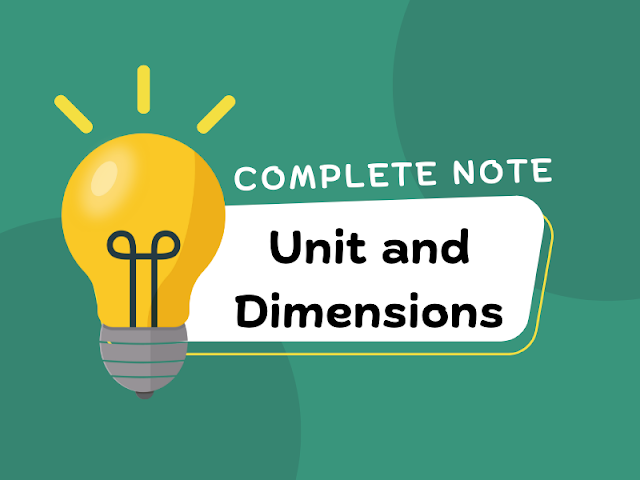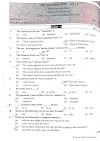Physical Quantities
The physical phenomena which can be measured are called Physical Quantities.
Length, Time, Speed, and Magnetic Field are Physical Quantities as they can be measured.
Smell, Taste are not Physical Quantities as they can not be measured in a general sense.
There are two types of physical quantities: Fundamental Quantities and Derived Quantities.
Fundamental Quantities:
The quantities that are independent of other quantities are called fundamental quantities.
There are seven fundamental quantities. They are Length, Mass, Time, Temperature, Electric Current, Luminous Intensity, and Amount of Substance.
Derived Quantities:
The quantities that are dependent on other quantities are called derived quantities.
Area = Length Length and Speed = . Here, area depends on length and speed depends on length and time hence they are derived quantities.
Other derived quantities are Volume, Force, Power, Intensity of sound, Magnetic Flux, etc.
Units
Unit is the standard reference in which physical quantity is expressed.
Length is expressed in meters and speed is expressed in meters/second. The meter and meter/second are the units.
System of Units
The standard references can vary based on which unit Mass, Length, Time, and other fundamental quantities are measured. On the basis of that, there are four systems of units. They are CGS, FPS, MKS, and SI systems.
Quantity CGS System FPS System MKS System 1. Length Centimeter Foot Meter 2. Mass Gram Pound Kilogram 3. Time Second Second Second SI system is an extension of the MKS system in which units of all fundamental quantities are included.
Quantity SI Unit Symbol 1. Length meter m 2. Mass Kilogram kg 3. Time Second s 4. Electric Current Ampere A 5. Temperature Kelvin K 6. Luminous Intensity Candela Cd 7. Amount of Substance Mole mol Types of Units
There are three types of units. Namely, Fundamental units, Derived Units, and Supplementary Units.
Fundamental Units: The units of fundamental quantities which are independent of other units are called fundamental units. There are seven fundamental units. eg. m,kg, s, K, Cd, Mol, A.
Supplementary Units: The units of plane angle and solid angle which are two purely geometric angles are called supplementary units.
Quantity Unit Symbol 1. Plane Angle Radian Rad 2. Solid Angle Steradian Sr Derived Units: The units of derived quantities which are dependent on fundamental units and supplementary units are called derived units. For eg. m/s, kgms, m/s etc.
To cover all the scientific measurements in terms of SI unit, the prefixes are used for the powers of ten.
Powers of Ten Prefixes Symbol Powers of Ten Prefixes symbol Yotta Y Yocto y Zetta Z zepto z Exa E Atto a Peta P femto f Tera T Pico p Giga G nano n Mega M micro Kilo K Milli m Hecto h centi c deca da deci d The size of the nucleus is in order of m and the size of an atom is in order of
Common Non-SI Units
SI units are commonly used worldwide and cover all scientific measurements. Due to historical, political, and situational significance, there are common Non-SI units in use.
Length
Common Non-SI unit Symbol Value in SI unit Significance 1 Astronomical Unit 1 AU 1.496 10 m The distance from Earth to the Sun 1 Light Year 1 Light Year 9.46 10 m The distance covered by light in one year 1 Parallactic Second 1 Parsec 3.084 10 m/(3.26 Light Year) the distance at which the length of one astronomical unit subtends an angle of one second of an arc. 1 Angstrom 1 1 10m named after 19th-century Swedish physicist Anders Jonas Ångström 1 Fermi 1 Fermi 1 10m The smallest unit of distance used in nuclear physics/ named after Enrico Fermi 1 X-ray Unit xu 1 10m used to quote the wavelength of X-rays and gamma rays. 1 Inch 1 " 0.0254 m Imperial System 1 Foot 1 ft/ 1' 0.3048 m Imperial System 1 Yard 1 yd 0.9144 m Imperial System 1 mile 1 mile 1609.344 m Imperial System 1 Nautical mile 1 Nm 1852 m Used in air, marine, and space navigation Mass
Common Non-SI unit Symbol Value in SI unit Significance 1 Pound 1 lb 0.4536 kg Imperial System 1 Slug 1 slug 14.59 kg British system based on standard gravity 1 Quintal 1 Q 100 kg historical unit of mass 1 Metric tonne 1 t 1000 kg historical unit of mass 1 amu 1 amu 1.66 10 kg precisely 1/12 the mass of an atom of carbon-12 Time
Common Non-SI unit Symbol Value in SI unit Significance 1 Minute 1 min 60 s Convenience 1 Hour 1 hr = 60 min = 3600 s Convenience 1 Day 1 day = 24 hr = 86,400 s Convenience 1 year 1 yr 1= 365.25 day = 3.156 s Convenience 1 shake 1 Shake 1 10 s Used in nuclear physics Other Conversion
Quantities Non SI values Value in SI unit Pressure 1 Pascal 1 Nm Pressure 1 atm = 760 mmHg 1.01 Nm Pressure 1 bar= 1 atm 1.01 Nm Pressure 1 torr= 1 mmHg 133.322 Nm Volume 1 liter = 1 cm Energy 1 eV 1.6 J Energy 1 erg 1 J Energy 1 KwHr 3.6 J Power 1 Hp 746 W Power of lens 1 D 1 m Plane Angle 1 Degree
Measurement
- The comparison of the amount of physical quantity in terms of standard reference of the same quantity is called measurement.
The standard reference amount is a unit (u).
The scale of the amount with reference to the unit is the numerical value (n).
Hence,
Measured Quantity(Q) = Numerical value (n) unit (u)
Eg. 10 Kg where, numerical value = 10 and unit = 1 Kg.
For a given measurement, the measured quantity is constant. i.e. Q = nu = constant.
Dimensions and Dimensional Formula
The dimensions of a physical quantity may be defined as the powers to which the fundamental units of mass, length, and time must be raised to represent the physical quantity.E.g
The dimension of velocity is 0 in mass, 1 in length, and -1 in time.
The dimension of velocity is 0 in mass, 1 in length, and -2 in time.
=
=
The dimension of force is 1 in mass, 1 in length, and -2 in time.
Different Types of Variables and Constants
Dimensional Variable: Quantities having dimension and variable values. eg. Acceleration, Volume, Force, etc.
Dimensional Constant: Quantities having dimension but constant values. eg. gravitational constant, Planck's constant, Stefan's constant, etc.
Non-dimensional Variable: Quantities not having dimension with variable values. eg. strain, angle, relative density, etc.
Non-dimensional Constant: Quantities not having dimension with constant values. eg. , , etc.
Non-Dimensional Quantities
Relative density
Angle and solid angle
Strain
Poisson’s ratio
Refractive Index
Mechanical Equivalent of Heat
Emissivity
Magnetic Susceptibility
Electric Susceptibility
Relative Permittivity
Relative Permeability
Coefficient of Friction
Loudness ( Decibel is the Unit of Intensity Level)
Dielectric Constant
Physical Quantities Dimension SI unit Area (A = ) [] m Volume (V = ) [] m Density () [] kg/m Acceleration () [] m/s Speed () m/s Momentum (p = mv ) kgm/s Acceleration () [] m/s Force () [] N Impulse () [] Ns Work () [] J Power() [] W Pressure() [] N/m
Use of Dimensional Formula
Conversion of one system of the unit to another.
If are the fundamental units on one system of units, are the fundamental units on the second system of units.
and, the dimensional formula of the physical quantity is then,
Where and are the numerical values in each system.
Example: Convert 1 Joule into erg.
Joule and erg are the units of energy. So, dimensional formula =
and Joule is the unit of the SI system and erg is the unit of the CGS system.
Hence,
Checking the consistency of the equation
The principle of homogeneity states that "dimensions of each of the terms of a dimensional equation on both sides should be the same. "
Example: check the consistency of the equation
Dimensional formula of
Dimensional formula of
Dimensional formula of
Dimensional formula of
Dimensional formula of
Hence,
Dimension of
Dimension of
Dimension of
Hence, the given equation is dimensionally consistent.
Note: The dimensionally consistent equations are not necessarily correct physical equations. But, dimensionally inconsistent equations are always incorrect physical equations.
Deriving the equation
Example: The viscous force acting on a sphere is directly proportional to the following parameters:
the radius of the sphere(r)
coefficient of viscosity()
the terminal velocity of the object
Find the expression for the viscous force on the sphere if the proportional constant is
Solution:
Using homogeneity of dimension:
Then,
solving we get,
Dimensional Formula of Important Physical Quantities
Physical Quantities Dimension SI unit Angular displacement() [] rad Angular velocity() [] rad/s Frequency() [] Hz Angular acceleration() [] rad/s^ Moment of Inertia() [] Torque() [] Nm Angular Momentum() [] Js Force constant() [] Nm Surface tension() [] Nm Gravitational Constant( [] velocity gradient( [] Coefficient of viscosity ( [] Gravitational Potential ( [] Planck's Constant ( [] Gravitational Intensity( [] Charge( [] Electric Potential ( [] Electric Dipole ( [] Current Density ( [] Capacitance ( [] Permittivity ( [] Resistance ( [] Conductance ( [] Combined Dimension:
The dimension of is the same as that of velocity. (E stands for Electric Field Intensity and B stands for magnetic field intensity.)
has the dimension of Time.
The dimensions of solar constant are
Physical Quantities having the same dimensions
Inertia and mass have the same dimensional formula.
acceleration, gravitational field strength, and acceleration due to gravity.
Linear momentum and impulse.
Work, energy, torque, couple, moment, internal energy, heat, work function.
Angular velocity, frequency, velocity gradient, radioactive decay constant .
Spring constant, force gradient, surface energy.
Pressure, stress, modulus of elasticity, energy density .
Gravitational Potential, specific latent heat.
Electric potential, EMF, and electric potential difference.
Intensity of radiation and solar constant.
Angular momentum and Planck’s Constant.
Magnetising force and intensity of magnetization.
Rydberg’s constant and wavenumber. .
Never memorize the dimensional formula of any physical quantity. Instead, memorize the formula which contains that physical quantity and try to obtain the dimensional formula of the designated physical quantity.
For eg; For calculating the dimensional formula of permittivity, we first have to know the Formula which uses the Permittivity. The simplest one which I come across is the following relation obtained from Coulomb's Law:
For vacuum
For medium
From the above relation, we know the dimensional formula of Force(F), Charge(q), and distance(r). is a dimensionless quantity.
Through simplification, we can easily obtain the dimensional formula of .
Where Is the permittivity of free space.
Non-Standard Bases of Dimensional Formula
Taking force, length, and time to be the fundamental quantities. Find the density, momentum, and energy.
Density
From homogeneity of dimension:
Solving, we get,
Momentum
From homogeneity of dimension:
Solving, we get,
Energy
From homogeneity of dimension:
Solving, we get,
Percentage Change
For percentage change
Equation type
Taking log in both sides,
differentiating,
Due to properties of logarithm:
The power is changed into multiplication.
The multiplication is changed into addition and
The division is changed into subtraction.
For percentage change
Equation type
If the percentage increase in x is ,
If the percentage decrease in x is ,
Errors in Measurement
There is a certain difference between the measured value and the actual value during measurement. It is called an error in measurement.
Error in Equation type
Taking log in both sides,
differentiating,
Error in Equation type
Relative Error:
There is no error of measurement in constant value.
The power is changed into multiplication.
The multiplication and division are changed into addition.




![[UPDATED] New Syllabus of IOE Entrance Examination |](https://blogger.googleusercontent.com/img/b/R29vZ2xl/AVvXsEj5C60n4l8guBTBqS4sBFaD1z9AoLPnKFQB_f1-F731bzrW_xcCsoewcBcUtqnpJhlf7lL5sOklAtsxRKdgZ-dCQiAgQb1T2X9ck-D_FYoU01fPdPA0mbsulZgmnkS-6-3Hg_CbxBExwn3z5c3-8srStMoZwr6SrmsgF5fPGjnD29T_lg1XsX3aZoIQm9k/w680/pic.png)


![[UPDATED] New Syllabus of IOE Entrance Examination |](https://blogger.googleusercontent.com/img/b/R29vZ2xl/AVvXsEj5C60n4l8guBTBqS4sBFaD1z9AoLPnKFQB_f1-F731bzrW_xcCsoewcBcUtqnpJhlf7lL5sOklAtsxRKdgZ-dCQiAgQb1T2X9ck-D_FYoU01fPdPA0mbsulZgmnkS-6-3Hg_CbxBExwn3z5c3-8srStMoZwr6SrmsgF5fPGjnD29T_lg1XsX3aZoIQm9k/w100/pic.png)

0 Comments